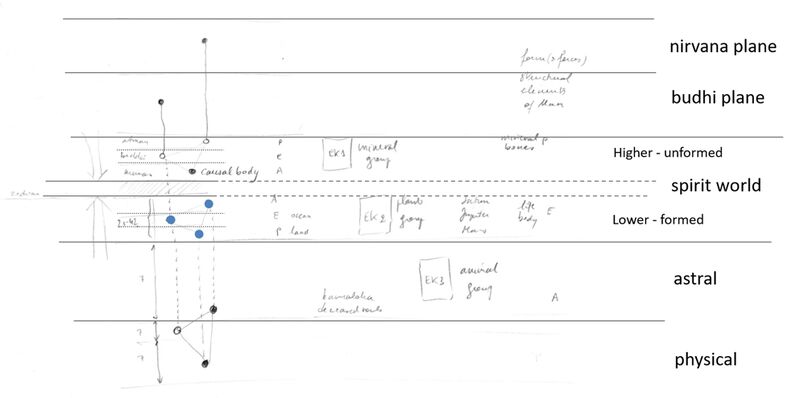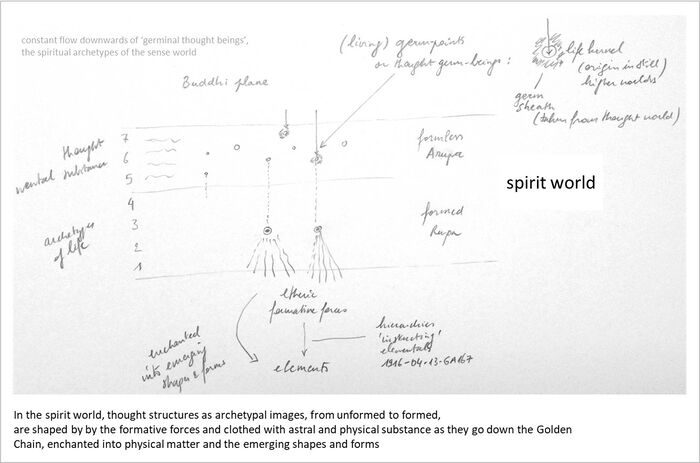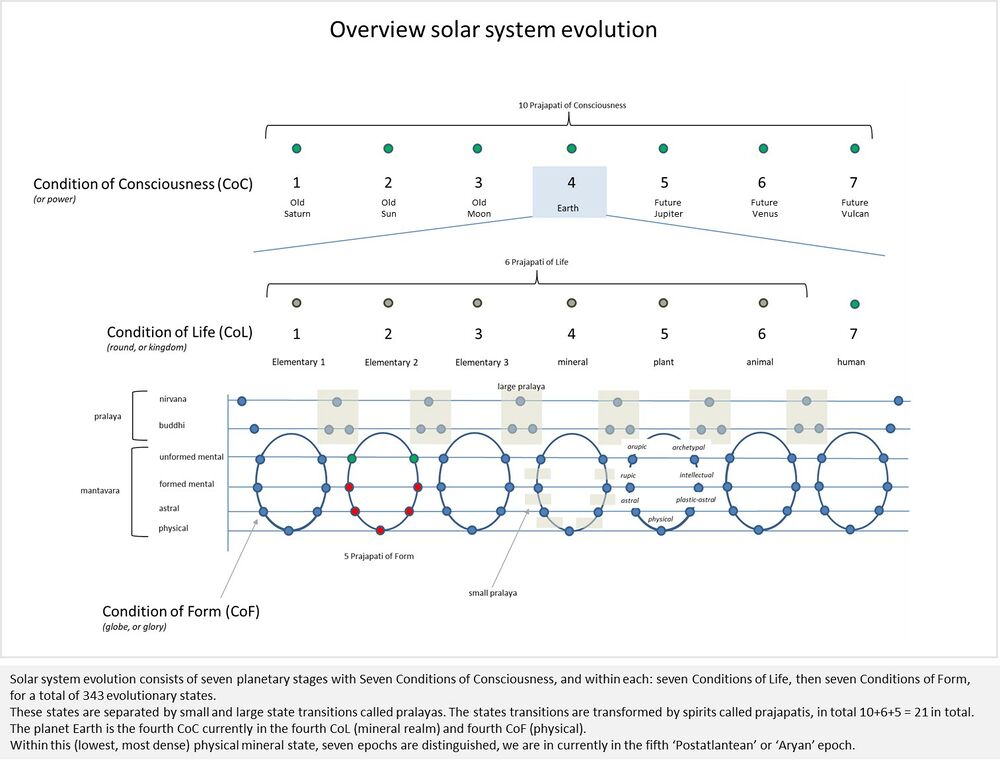Monad
The monad is a unit or entity of the divine Logos, consisting of (both descriptions exist) either spirit-man (or atma) alone, or both spirit-man and life spirit (or budhi) together, and to be positioned on the nirvana and budhi planes.
The concept of the monads, as related to the 'seven creative spirits before the throne' also comes back in theosophy as the so-called 'seven rays' that lie between the lower worlds (physical, astral, and higher and lower spirit worlds) and the three Logoi.
The monad of atma and budhi represents the innermost life-kernel of Man's divinity, Meister Eckhart's 'godly spark'. This divine core, or Man's monad, is what descends to find sheaths in the lower worlds, starting with the spirit-man (atma) and life-spirit (budhi) that connect with a spirit self (manas) in order to find individual self consciousness or individuation.
Man's higher triad consisting of spirit-man, life-spirit and spirit-self makes up the first series of sheaths in the unformed higher spirit world. The spirit-self or causal body is the permanent Individuality of Man. The seven bodily principles or members of Man's being are all sheaths for the human monad. Man crafts and fills the scaffold created by the spiritual hierarchies as part of the process of Individuation (becoming an autonomous human 'I') and Man's transformation and spiritualization (of the lower bodily principles).
Note that the term monadism historically arose as part of a variant spiritual worldview based on a multitude of monads - a monad imagined as an abstract concept of a self-contained, self-sustaining eternal being - as an antithesis to mysticism based on experience of unity.
Aspects
- distinction between original use of the term (see 'historically') and the concept of monad as used in theosophy and anthroposophy
- evolutionary
- the animated monad of spirit-man (atma) and life-spirit (budhi) was created as a spiritual scaffold during the Old Saturn and Old Sun planetary stages of evolution, during the last Conditions of Life of these stages (1904-GA011, Schema FMC00.482)
- descent of the monads in the Lemurian epoch, see Development of the I: the monads are beings who descended from the nirvana plane and are in the human being (1905-10-11-GA093A, 1904-02-18-GA090A)
- positioning
- from above downwards: Schema FMC00.060 and Schema FMC00.061 show the properties of The three Logoi and Seven creative spirits. Schema FMC00.062 below (also on Creation by the three Logoi) positions these to the nirvana plane.
- from below upwards: Schema FMC00.128 depicts how Man's spirit-man and life-spirit contain a life kernel of atma and budhi originating in the higher worlds of budhi and nirvana planes
- terminology-wise, Rudolf Steiner sometimes calls uses the term monad for Man's higher triad, see eg Development of the I#1905-10-24-GA093A that describes the phase in the Lemurian epoch when the monad and higher triad entered into Man with the formation of the human I.
- see more on the 'seven rays' on Seven creative spirits
historically
- monadology or monadism, as a worldview (see Schema FMC00.648)
- the world is founded on the activities of a multiplicity of monads, or spiritual beings (1910-02-10-GA059)
- monad: abstract concept of a self-contained, self-sustaining eternal being. Feeling-wise: the immortal power to preserve the past existence in memory (imagine the soul carrying itself through the eternities) (1912-08-28-GA138)
- representatives
- Giordano Bruno, Gottfried Wilhelm Leibniz (or Leibnitz) (646-1716), Johann Friedrich Herbart (1776-1841)
- Hamerling, see Schema FMC00.648A
- monadism (with its multiplicity) as a antithesis to mysticism (as the mystic's path leads to unity, to one divine-spiritual being); and "all those who have sought for unity on the outward path were subject to an illusion, for they projected outwards, like a sort of shadow, the unity which is experienced inwardly in mysticism, and they believed that this unity was the basis of the external world and could be apprehended by thinking." (1910-02-10-GA059)
- the concept of the monad also appears in Pythagoras, whereby the monad refers to a single source and indivisible origin for all the diversity in the universe. The Monad was the first divine being or thing that came into existence giving rise to the totality of all beings.
Illustrations
Schema FMC00.062 depicts the spiritual entities involved in creation of cosmic systems like our solar system. Our solar system is described as everything upto the spirit world, with the spiritual hierarchies involved in a great dynamic interaction as explained in the Golden Chain. The spirits described in this schema are above that, and operate from nirvana and buddhi planes, orchestrating the changes at the highest level including transitions between the stages of consciousness (CoC), conditions of life (CoL) and conditions of form (CoF).
Note: The evolutionary dynamic is ongoing at all times for all hierarchies simultaneously and in parallel. In terms of the specific guidance for the development of humanity, it is also from these higher planes (buddhi and nirvana planes), that the White Lodge circle of Boddhisatvas and Buddha's operate and guide the evolution of Mankind, guided by the Christ, see the Occult atom.
Schema FMC00.062 shows the main creative entities at the highest level (as per GA089):
Schema FMC00.128 positions Man's higher triad against the Human 'I' or threefold soul, along the planes or worlds of consciousness.
Schema FMC00.141A: shows the layers of the spirit world, and how the living germ-point kernels in the spirit world are parts of the monad that stream in from still higher worlds, the budhi and nirvana planes (see Planes or worlds of consciousness), and are clothed with form and substance in the worlds below.
This is the original pencil drawing that was the basis for Schema FMC00.141 in context of the Golden Chain.
Schema FMC00.057D provides an explanatory overview of the 343 states in the solar system evolution, with summary info from Three dimensions of evolution.
For the linkage of Schema FMC00.062 to the below, see also Three classes of Buddhas#Note 2 - Model of creation and positioning Dhyani-Buddhas.
Schema FMC00.482: shows how the scaffold for the principles of Man's higher triad were added in the planetary stages of evolution through the work of an ever-higher spiritual hierarchy, alongside the lower bodily principles.
This is a compilation based on descriptions in 1904-GA011 (Cosmic Memory) and 1909-GA013 (Outline of Esoteric Science). The components for each planetary stages can also be found in the last Condition of Life (CoL) for each Condition of Consciousness (CoC) planetary stage, see eg Schema FMC00.276 and Schema FMC00.199 and the study module Evolution Module 1 - Foundation. This depiction therefore comes back in writings of anthroposophists such as Iwer Tor Lorenzen (on the I principle) and Maximilian Rebholz.
Lecture coverage and references
Helena Blavatsky in The Secret Doctrine (1888)
describes the monad not just viewed as one, but also a dual monadic principle that develops to a triad, quotes below SWCC
quoteA
The [word] monad is from Greek “One” the unit, whatever it is. . . . atma in reality is not a unit, but the one universal principle, and it is simply a ray. That which uses buddhi as a vehicle is that ray of that universal principle. Therefore, in reality it is buddhi which is the monad, the one unit.
quote B
The monad of every living being . . . is an individual Dhyan Chohan, distinct from others, a kind of spiritual individuality of its own, during one special manvantara. Its primary, the spirit (atman) is one, of course, with paramatma (the one Universal Spirit), but the vehicle it is enshrined in, the buddhi, is part and parcel of that Dhyan-Chohanic essence.
quoteC
atma and buddhi cannot be predicated as having anything to do with Man, except that Man is immersed in them. So long as he lives he is overshadowed by these two; but it is no more the property of that than of anything else
quote D
The monad is impersonal and a god per se, albeit unconscious on this plane. For, divorced from its manas principle ... it can have no consciousness or perception of things on this earthly plane. “The highest sees through the eye of the lowest” in the manifested world; Purusha (spirit) remains blind without the help of prakrit (matter) in the material spheres; and so does atma-buddhi without manas.
quote E
Buddhi being the first differentiation, the first ray, it is universal consciousness, and could not act on any one plane, especially on the terrestrial plane. And to be conscious of something, of somebody, it must have manas, that is to say, the consciousness of this plane.
1904-GA009
Maximilian Rebholz remarks:
In earlier lectures by Dr. Steiner , this life-kernel was also named Man's monad, and in the first edition of 'Theosophy', there is a sentence related to this, which had been left out in the later editions:
and quotes:
The unification of Life Spirit and Spirit Man is that, which Man since ancient times calls the human 'monad'. Such monads lie at the foundation of all that exists. They build their spirit, soul and physical organisations made from the three worlds, in order to live and work within those worlds.
1904-GA011
From the middle of the 6th solar cycle (see: CoL on Old Sun), man himself is so far advanced that he can work unconsciously on his physical body. In this respect he now replaces the sons of twilight (the angeloi). Through this activity he creates in dullness the first seed of the living spiritual being, which is called the spirit of life, budhi.
Only at later stages of his development will he bring this life-spirit to consciousness. Just as from the 7th CoL on Old Saturn onwards the Thrones voluntarily poured their power into the spiritual human being (atma) formed there, so now the cherubim pour their wisdom, which from then on remains preserved in the life spirit of Man through all subsequent stages of development.
From the middle of the 7th CoL on Old Sun, the germ of the spirit man, atma, which was already predisposed on Old Saturn, emerges again. It combines with the spirit of life, budhi, and the animated monad (atma-budhi) comes into being.
1904-02-18-GA090A
See: Man's higher triad#1904-02-18-GA090A
Our Self, the part that incarnates, originates from still higher planes [than the spirit world]: it originates from the actual divine homeland of Man called the budhi and nirvana regions. From these two regions Man really originates.
1905-10-11-GA093A
about descent of the monads in the Lemurian epoch, see long quote on: Development of the I#1905-10-11-GA093A
It can only come from Nirvana. At that time something had to become active in the world that came forth from Nirvana, from that which is ‘created out of nothing’. The beings who at that time fructified the Earth had to reach up into Nirvana. Those who fructified the four-footed creatures so that they became human, were beings who descended from the Nirvana plane. They are called Monads. This is why at that time beings of this nature had to come down from the Nirvana plane. The being from the Nirvana plane who is in us, in the human being, is the Monad.
1910-02-10-GA059
quote A
The mystic's path leads him to unity, to one divine-spiritual Being. This he does by following the path which leads into his inner being where the I gives him the unity of soul experience. The other path is the one that the human spirit has always taken when it seeks to pierce through the veil of the external world to the foundations of existence. Here, in conjunction with many other things, it has been above all the human thinking which has tried to reach a deeper understanding of what lies behind the surface of things through that which can be perceived by the senses and grasped by ordinary intelligence. Whither does such a path necessarily lead, in contrast to the goal of mysticism? If all relevant relationships are taken into account, it must lead from the manifold variety of external phenomena to the conclusion that a similar multiplicity of spiritual grounds must exist. In modern times such men as Leibniz and Herbart, who followed this way of thought, have seen that one cannot explain the wealth of external phenomena in terms of any kind of underlying unity.
In brief, they found the true antithesis - monadology - to all mysticism. They reached the view that the world is founded on the activities of a multiplicity of monads, or spiritual beings.
Thus Leibnitz, the great thinker of the 17th and 18th century, said to himself: When we look at what comes to meet us in space and time, we go astray if we believe that it all springs from a unity; it must come from many unities working together. And this reciprocal activity of monads, a world of monads or spiritual beings, brings about the phenomena perceived by human senses.
I cannot go further into this today, but a deeper study of spiritual development would show that all those who have sought for unity on the outward path were subject to an illusion, for they projected outwards, like a sort of shadow, the unity which is experienced inwardly in mysticism, and they believed that this unity was the basis of the external world and could be apprehended by thinking. Healthy thinking, however, finds no unity in the outer world, but recognises that its manifold variety arises from the inter-working of a variety of beings, or monads. Mysticism leads to unity because the ego works in our inner being as a single centre of the soul. The path through the external world leads by necessity to multiplicity, plurality, monadology, and thus to the view that many spiritual beings must work together in order to engender our world, while human knowledge of the world is achieved through a multiplicity of organs and observations.
Now we come to a point of far-reaching importance which receives all to little attention in the history of thought. Mysticism leads to unity; but its recognition of the divine ground of the world as a unity derives from the nature of the I, the inner constitution of the soul.
The I sets its seal of unity when the mystic looks up to the Divine Spirit. Contemplation of the external world leads to a multiplicity of monads. But it is only our way of observing the outer world and the way in which it comes to meet us that lead to multiplicity and which therefore prompted Leibniz and Herbart to postulate multiplicity as the foundation of the world. Deeper research leads to a realisation that unity and multiplicity are concepts inapplicable to the divine-spiritual ground of the world, for we cannot characterise it as either a unity or a multiplicity. We must say that the divine-spiritual transcends these concepts and cannot be fathomed by them.
This is a principle which throws light on the supposed conflict between monism and pluralism, so often portrayed as opposites in philosophical debates. If the disputants would only realise that their concepts are inadequate for any approach to the divine ground of the world, they might come to see the subject of their debate in the right light.
1912-02-15-GA061
The idea (of the lawful connection between the human soul and the spiritual-soul of the world), which Aristotle had found in himself, which had proved its momentum and its fruitfulness in relation to the external world, shrank with Giordano Bruno and later with Leibniz to what Giordano Bruno and then Leibniz called a monad. A monad was something that was thought to be born out of the spiritual world. For Leibniz, even a monad contained something like a reflection of the whole universe. But more recent culture has not achieved anything more than a dry abstraction: the monad, a reflection of the universe, something that contracts and expands again in order to pass through the universe again
1912-08-28-GA138
To be immortal means to have the power to preserve in memory the departed, the past existence. This is the actual definition of human immortality.
Through initiation the proof is provided, the proof of experience, that powers live in Man which (enable him to) remember everything he has experienced in the senses and in general after the sensual body has been laid aside. The human being is of such a nature that he carries his own being through future times by the powers of supersensible memory.
If you feel this thought, feel it into the emptiness of the universe in such a way that you imagine the soul carrying itself through the eternities, then you have a much better definition of what is called a monad than could be given by any philosophical concepts. For then you will feel what a monad is, a self-contained, self-sustaining being.
After all, ideas about these things can only be gained through the experiences of initiation.
Maximilian Rebholz
We know from Cosmic Memory (GA011), that atma was predisposed at the end of the Old Saturn development, buddhi towards the end of the Old Sun development, and manas in the fifth round of the Old Moon development. This atma, which on a higher plane is an emanation from the Thrones as is the warmth of Old Saturn, became the bearer of that primordial being of humanity called the monad, which designates the innermost self of the human being. The monad was enveloped, so to speak, by atma and added buddhi on Old Sun and manas on Old Moon as further sheaths or veils.
And just as one can first speak of atma, buddhi, and manas only as a general, undifferentiated sea of spirit substance, so until the beginning of earthly incarnations in the Lemurian period, there was only one human monad, one great, undifferentiated self of humanity. Only through the addition of the I-bodies, which the Spirits of Form generated out of their sacrificial substance, could the division of the general monad into the many individual souls take place.
And only now during the earthly life can the individualization of manas, buddhi, and atma into the spirit self, life spirit, and spirit man occur through the work of the ego on the astral body, etheric body, and physical body. Although atma, buddhi, and manas are there in the universe for the human being as they are his inheritance from the sacrificial acts of the Thrones, Spirits of Wisdom, and Spirits of Movement (and also of the Cherubim and Seraphim as shown in the second section of the essay “About the Elementary Kingdoms”), the human being must first acquire this cosmic inheritance through a lengthy individual effort in order to possess it. And this acquisition happens precisely through the work on the lower members of being. Here the human being meets his own spiritual-substantial essence, for the spirit of the astral body is manas; the spirit of the etheric body is buddhi, and the spirit of the physical body is atma. We see this most clearly in the physical body when we have worked out the concept of the phantom. The forces shaping the phantom are atma forces. Correspondingly, we can assume something similar for the etheric and astral bodies.
...
So far, we have considered manas, buddhi, and atma primarily in terms of their substantial side, namely as the spiritual substances from which we build up the three higher entities: spirit self, life spirit, and spirit man. But even before its individuation, the human monad, that is, the innermost human essence, lives within these spiritual substances as if enveloped by them.
...
What we have called the monad is called the life kernel' in Theosophy. We saw in the previous section that the original and actual bearer of the monad is the atma. The addition of the buddhi during the Old Sun development produced the “animated monad.” When this animated monad also shrouded itself in the manas element during the development of Old Moon, the human being received a member of being that apparently no longer belongs as directly to his 'life kernel' as do atma and buddhi. This manas element is substantially equivalent to the thought substance of devachan. The 'life kernels' envelop themselves in this thought substance as they descend from even higher worlds into the devachanic world.'
Out of the element of the thought-world only the germ-sheath, as it were, is taken. And this surrounds the true life kernel. With it we have reached the confines of the 'three worlds (physical, astral soul world, and spirit world) for the “kernel” has its origin in still higher worlds. When man was described above according to his component parts this “life kernel” of the human being was specified, and its components were called “Life Spirit” and “Spirit Man.”
1904-GA009 Theosophy, Chapter 3, Part 3: Spiritland
So this life kernel is the true I, and the 'still higher worlds' are those that in the cycle Secrets of the Threshold (GA147) are called the supra-spiritual world.
Discussion
Related pages
Further reading and references
- Theosophy wiki page for monad
- blavatskytheosophy.com: What Exactly Is The Monad?





